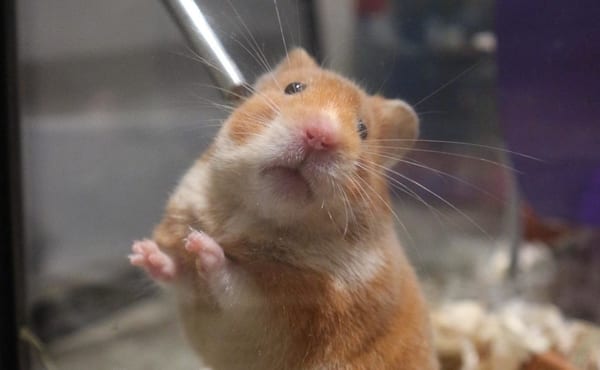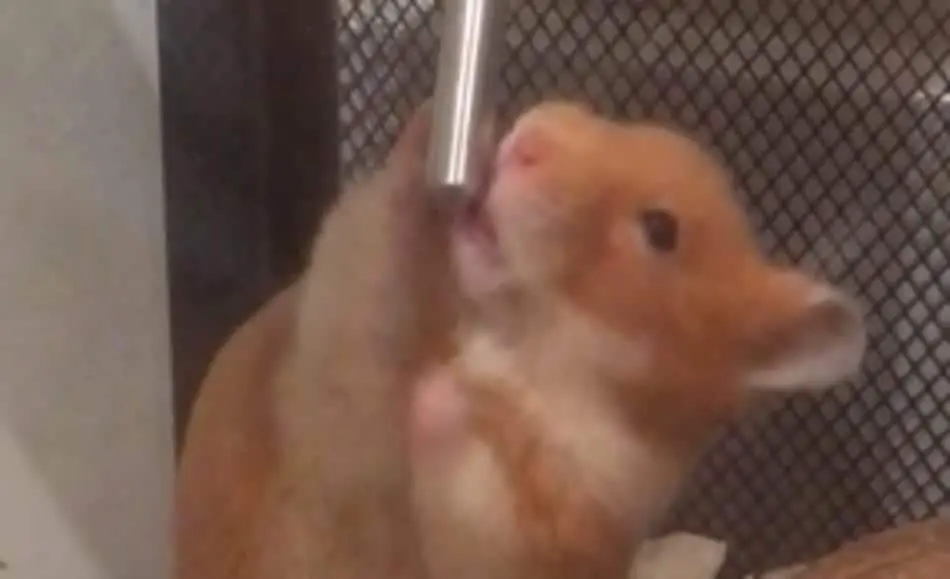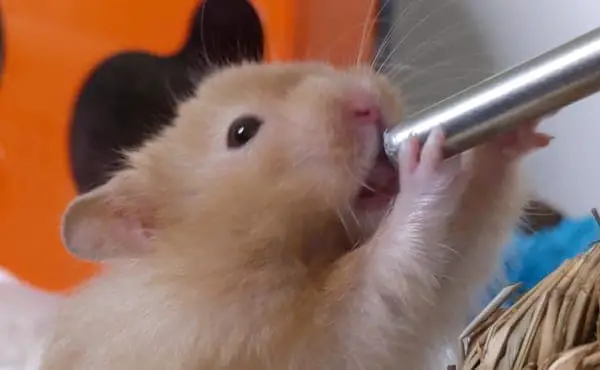One of the best ways to monitor your hamster’s health is to pay attention to its eating and drinking habits. A change in food or water intake is often one of the first signs that something may be off, although it can also be traced to regular changes in temperature, activity, or diet.
Why does my hamster drink so much water? Excessive drinking could be related to your hamster’s diet or activity level. It could also be a sign of kidney disease, especially if your hamster is getting old. Or an indication that your hamster has developed diabetes.
This article will discuss how much water a normal, healthy hamster usually drinks each day along with ways in which diet and activity can cause your hamster to drink more or less. It will also dive into the symptoms of kidney disease and diabetes that often accompany excessive drinking and include tips on how to help your hamster avoid these health issues.
How Much Water is Too Much?
Before you set about determining why your hamster is drinking so much water, it’s helpful to know how much water hamsters normally drink. Although it was commonly believed at one time that hamsters can survive unusually long amounts of time without drinking, this is actually not the case.
Hamsters need to drink as regularly as most animals and will only survive for one to three days without water.
Hamsters Fluid Needs Based on Size
In general, hamsters drink about 10 milliliters of water per 100 grams of body weight (or 0.33 fluid ounces per 3.5 ounces of body weight) every day. So Syrian or Golden hamsters, as the largest hamster breed, will need the most water, while Robos will drink the least.
Syrians usually weigh about 1 ounce per inch, so a 6-inch hamster will drink a little over half an ounce of water each day. Robos on average weigh about 0.75 to 1.5 ounces, and Chinese and Russian dwarfs are a similar size or slightly bigger, bringing their water intake down to a fraction of a fluid ounce.
There is no need to specifically measure how much your hamster is drinking, but if you notice the water in the bottle decreasing drastically (assuming there are no leaks!) your hamster may be drinking more than is usual.
Water Bottle Issues
It’s wise when determining if your hamster is drinking more than usual to make sure that it is actually drinking. Some hamsters can become water bottle chewers. They may gnaw continuously on the stem of the water bottle, causing water to drip into the bottom of the cage.
A leaking water bottle will also show significant decreases even though your hamster may be drinking a normal amount. You can tell if water is being leaked out of the bottle by checking the bedding underneath the bottle for excess moisture.
Hamsters will also return frequently to a water bottle that they are struggling to extract water from. If your hamster licks and jerks at the water bottle but doesn’t always appear to get water from it, make sure the bottle has not developed a vacuum or become clogged. Water should drip out easily when you gently tap the ball at the end of the spout with your fingertip.
Healthy Reasons a Hamster May Drink More
Although a dramatic increase in water intake could indicate that your hamster is suffering from a health issue, there are a few non-health-related reasons a hamster may drink more than usual.
A Dry or Warm Environment
Just like us, hamsters need more water if their environment is especially warm or dry. If the room where you keep your hamster is not air conditioned, you may notice your hamster drinks more during the summertime. Conversely, a house also becomes drier and warmer as it is heated, possibly causing your hamster to drink more in the wintertime.
Increased Activity
A hamster that is very active will naturally need to drink more than one that is sedentary. Since hamsters are nocturnal or crepuscular, your hamster will probably drink most often during the night. Younger hamsters in good health also tend to drink more than elderly hamsters as they are awake and active for longer periods of time.
A Dry Food Diet
Hamsters on a diet of mainly dry foods like pellets, grains, and seeds will also drink more than hamsters whose diet includes fresh vegetables. This is natural and doesn’t necessarily mean that your hamster’s water intake has changed. Hamsters with vegetables in their diet will get some of their water from the plant food.
Pregnancy
A final reason that a hamster in good health may drink more water than usual is pregnancy. A pregnant hamster will also consume more food and begin to look slightly round. She may be more irritable than usual, sleep more, and engage in more nesting behavior.
The increased intake of food and water will continue as she nurses her babies, usually for about two weeks after they are born.
Diabetes in Hamsters
Hamsters can suffer from Type 1 or Type 2 diabetes, and one of the first symptoms is excessive thirst. Diabetes is the result of a pancreas that isn’t producing enough insulin to absorb the glucose provided by your hamster’s food.
As the glucose builds up in your hamster’s bloodstream, your hamster’s kidneys will try to flush it out in the urine, causing your hamster to lose fluid and need to drink much more water than usual.

Other Symptoms of Diabetes
Along with excessive drinking, the following symptoms will help you determine whether your hamster is suffering from diabetes.
Increased appetite: As lack of insulin keeps the body from properly absorbing and using the energy provided by food, your hamster’s body may feel like it is starving, causing it to eat much more than usual.
Increased urination: This goes right along with the fact that your hamster is drinking so much. Its kidneys are trying the flush out the glucose that is building up in the bloodstream rather than being absorbed and converted to energy.
Mood swings and/or lethargy: As it struggles to convert glucose to energy, your hamster may show an overall decrease in activity or have short bursts of activity followed by lethargy.
Weight loss: Despite the fact that it is eating and drinking so much more than usual, your hamster is unable to utilize the nutrients it consumes. This can lead to its body converting fat and muscle to energy, causing it to lose weight.
How to Manage Diabetes in Hamsters
If you suspect that your hamster is suffering from diabetes, you can test its urine using a Keto-Diastix test, available in pharmacies or online. Whether the test comes back positive or negative, it’s important to consult an exotic animal vet for further advice.
They can educate you on the best type of diet to offer as well as anything else you can do to help your hamster manage its glucose levels. If the test indicates that your hamster is not suffering from diabetes, it’s just as important to find out what could be causing its symptoms.

Kidney Disease in Hamsters
Kidney disease is another common health issue that causes hamsters to drink excessively. It’s most commonly seen in older hamsters and female hamsters. Symptoms of kidney disease occur when a protein called an amyloid begins to be deposited in your hamster’s kidneys.
Other Symptoms of Kidney Disease
Constant thirst and urination are two of the most obvious and common symptoms of kidney disease. Again, this is a result of your hamster’s kidneys trying to flush out the toxin build-up. They may be seen in conjunction with the following symptoms.
- Blood in the hamster’s urine
- Weight loss
- Water retention which exhibits as a swollen abdomen
- Hair loss
- Sticky eyes
Other Diseases With Similar Symptoms
Along with diabetes and kidney disease, increased water intake and urination could be symptoms of Pyometra, Cushing’s and liver disease. It’s always best to consult your vet if you think your hamster could be suffering from any of these ailments.
Conclusion
In conclusion, your hamster’s excessive thirst may be due to environmental causes, high activity levels, or a dehydrated diet. However, it’s also possible that it has developed diabetes, kidney disease, or another illness.
Some of these diseases are more treatable than others, so it’s important to get your pet to the vet as early as possible, especially if you notice any of the other symptoms discussed here.
The good news is that most of these diseases are easily preventable. You can decrease your hamster’s odds of developing diabetes or kidney disease by always providing fresh, clean water and offering a well-balanced diet that includes fresh vegetables and limits sugary treats.
It’s also important to keep your hamster in a clean, temperature-regulated environment where it won’t get too hot or too cold and where bacteria is unlikely to flourish.



